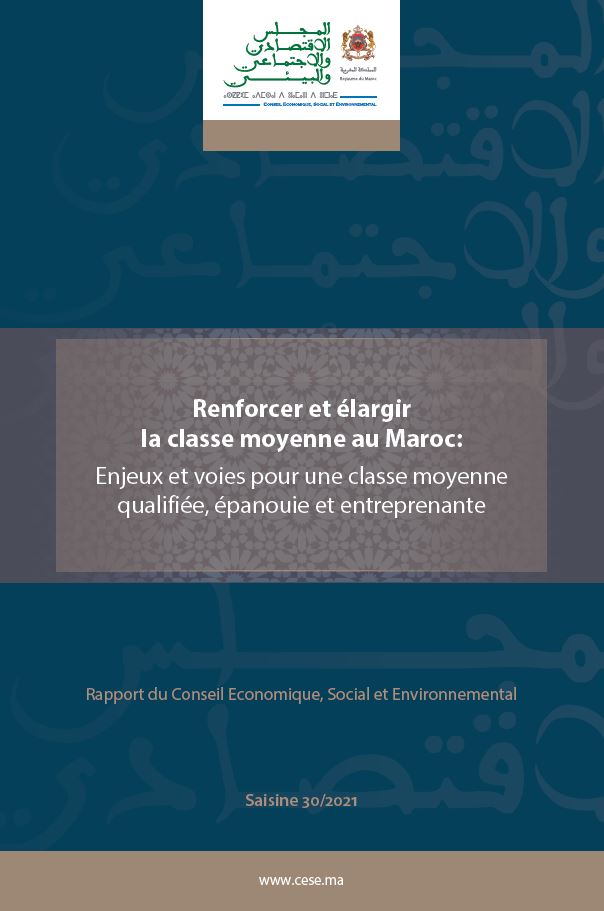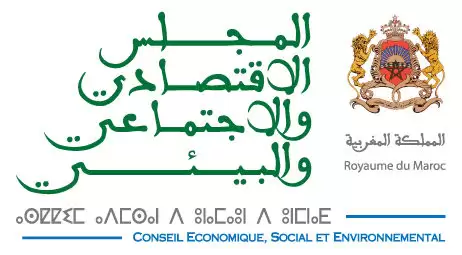
SR-CT-032020-30-7044-fr
In Morocco, many constraints make it difficult to define the middle class. These include the public policy statistical approach to define the middle class based on the income or consumption level. .
The CESE holds the opinion that statistical data alone (the income or the level of consumption) does not allow to define the parameters of a social class. The definition of the middle class, the CESE argues, must be based on observing the social strata living in satisfactory housing and depicting good socio-economic status (SES), which encompasses inter alia educational attainment and career aspirations.
On this basis and considering the economic and social specificities of our country, eight major avenues have been identified by the present opinion to expand the middle class in Morocco, but also to consolidate this social segment to cope with possible external shocks that could lead to social downgrading.
The CESE carried out this opinion on the middle class in Morocco upon request from the Speaker of the Chamber of Councilors (Moroccan parliament’s Upper House) on 30 January 2020. For the record, this request-based opinion report follows on from the conclusions of the fifth international parliamentary forum on social justice that was co-organized by the two parties on the theme “Expanding the middle class as a key driver of sustainable development and social stability”.
The middle class is a crucial medium for economic growth and stability. For a stronger and prosperous middle class sustains consumption, drives greater investment in education, health and housing, and plays a key role in supporting social protection systems through its taxes contributions. Also significant, a middle class with savings capacity is an important lever for funding investment.
Moreover, a prosperous middle class champions political stability. For it provides the kinds of conditions that are conducive to social cohesion and less inequality and creates the path to upward movement on the social ladder.
Although the middle class has been extensively studied in academic literature, developing a specific definition of this segment of society is still far from easy, and it is often compounded by the complexity of the situation.
In Morocco, many constraints make it difficult to define the middle class. These include the public policy statistical approach to define the middle class based on the income or consumption level. The lack (since 2009) of regularly updated data on the middle class, the weakness of the statistical framework for tracking salaries in the private sector, the size of the informal sector, the weakness of statistics related to it, and the lack of statistical information about unaccounted non-salary income, all constitute major difficulties that hinder an effective and precise definition of the middle class in Morocco.
The CESE holds the opinion that statistical data alone (the income or the level of consumption) does not allow to define the parameters of a social class. The definition of the middle class, the CESE argues, must be based on observing the social strata living in satisfactory housing and depicting good socio-economic status (SES), which encompasses inter alia educational attainment and career aspirations. It is this multidimensional approach that best characterizes the middle class in many ways and enables it to play its role as a basis for socio-political stability and a catalyst for our country’s socioeconomic and cultural development.
On this basis and considering the economic and social specificities of our country, eight major avenues have been identified by the present opinion to expand the middle class in Morocco, but also to consolidate this social segment to cope with possible external shocks that could lead to social downgrading. These are (i) fully redistributive budgetary and fiscal policies; (ii) the eradication of poverty and assistance for the most modest and vulnerable populations; (iii) economic empowerment to reduce poverty among women in urban and rural areas and promote greater access for women to the labor market; (iv) improving the quality of social services; (v) strengthening the skills of human capital; (vi) organizing and developing civil service professions; (vii) promoting the emergence of a rural middle class; and (viii) developing an inclusive digital infrastructure.
In accordance with these guidelines, the CESE proposes in this study a list of operational recommendations. The two-pronged objective is to better define the middle class by exploring an alternative definition and, at the same time, preserve and grow the middle class to be prepared to fully play its role in the development of our country. Key among these recommendations are that:
The resources of the national statistical system should be modernized and scaled up by: (i) improving the tracking both of salaries in the private sector and non-salary income in Morocco; and (ii) developing indicators measuring the purchasing power, living conditions and wealth of different social strata across all regions and residential parcels in Morocco.
The middle-class purchasing power should be strengthened by introducing more favorable tax treatment of middle-income household that takes into account dependents and is accompanied by family allowances (such as relates to children’s education) that are more in tune with the socio-economic reality of families.
Women should be put at the center of anti-poverty efforts, and the policies and programs that are often based on a hierarchical concept of headship where the “head of household” role is automatically ascribed to the male should be discarded.
The regulation of the healthcare system should be based on a reliable overall health map (national and regional) that covers the public and private sectors. In this respect, the role of the State is key to establish a health care model that ensures and monitors the uniform delivery of high-quality, close healthcare services.
Lifelong skill-based training should be reinforced, while offering Recognition of Prior Learning (RPL) and creating new bridges and ladders in the acquisition of educational qualifications across different national education systems.
Non-agricultural economic activities in rural areas should be promoted and diversified. The aim is to promote the emergence of a genuine middle class among the 50% of the rural population whose activities do not relate to agriculture.
Consider the building of emerging rural areas. This should be part of the State’s regional planning efforts to help rural areas make effective use of rural assets. The aim is not to erect barriers for rural residents considering an urban move (rural-urban migration) but rather to ensure that rural areas and communities remain attractive places to live and work.
The role of new information and communication technologies (ICTs) should be recognized as an essential tool in the production and acquisition of knowledge. As such, these should be incorporated in school, university and vocational training structures. Furthermore, traditional and digital channels should be combined and used together in a consistent way across all disciplines: law, economics, human and social sciences, engineering, marketing, accountancy, etc.
